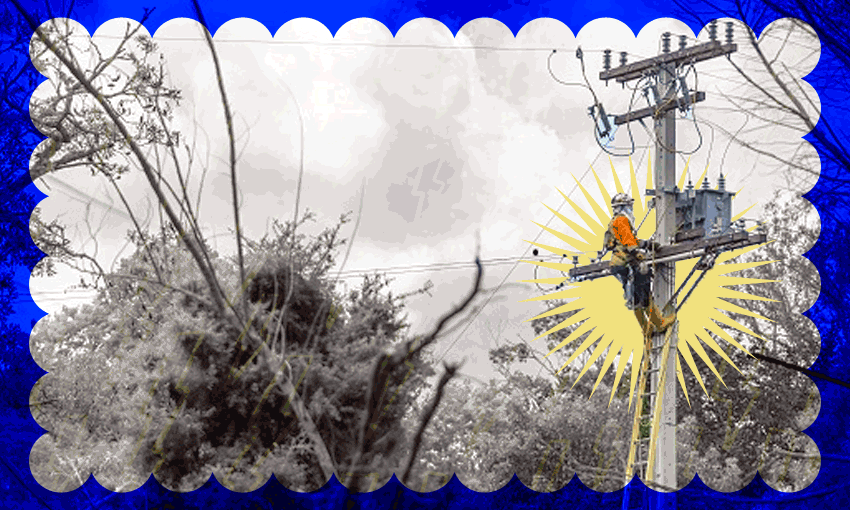Climbing a big pole in a storm sounds like a bad idea, but someone has to do it. Lines expert Richie Inglis tells Shanti Mathias about the practical details of restoring power.
“We have heaps of work to do,” says Richie Inglis, in one of this week’s many understatements. Inglis assesses and organises electricity line repairs for Vector, New Zealand’s biggest electricity distributor, based in Auckland. After the devastating impact of Cyclone Gabrielle, the workload is immense. “It’s pretty bad,” he says. “A lot of trees, even from 20 or 30 metres away, have fallen on our lines and there are landslips too.”
Electricity infrastructure throughout the North Island was damaged by the cyclone; on Tuesday 225,000 households didn’t have power. Many people have had their power restored due to the hard work of line mechanic teams. However, due to inaccessible roads preventing equipment and people getting through, some places may remain without power for weeks.
Not having electricity impacts the obvious stuff – cellphones run out of battery power, there are no lights for houses at night; often telecommunications require power too. But in an electricity-dependent society, other basic necessities rely on the grid too. Napier is using generators to pump the town’s drinking water supply, a lack of refrigeration in warm weather can make food go bad, people with electric mobility aids can find it hard to get around. While microgrids, home generators and solar roof panels may become more widely used, for now restoring the mainstream power grid is urgent.
Vector’s teams are experienced in developing “plans of attack” for repairs. Inglis checks in with teams across Auckland as they evaluate their options, sort the tasks into a list and talk about how to mitigate risks. It can be a multi-step process: Inglis gives the example of a broken or damaged pole that needs replacing. “If there are trees around it, we have to get a tree contractor in to clear the trees before we get there,” he says. “Then we take off all the conductors, remove it, dig a new hole, get the pole in there, and put everything back up.”
At the moment, with thousands of people without power, prioritising repairs is challenging. Vector receives reports from the public, as well as monitoring lines themselves – with drones and helicopters, from their control room, and by sending data to electricity meters to check they’re on. Sometimes damage is done to a “feeder” line that can cut off a whole suburb; at other times, only part of a street is left in the dark.
“In the first 72 hours, we’ve been trying to make the areas [that need repairs] smaller,” Inglis says. “We’ve had to wait for the wind to die down to scope out the repairs.” Sequencing is essential. The team is focusing on getting the “backbone” of the system operational so that smaller repairs, to houses and streets, can be done next.
One of the reason’s restoring electricity was particularly difficult during the cyclone was the high winds, which made it extremely dangerous to do things like climb high power poles or move big pieces of equipment.
Health and safety regulations have tightened considerably since Inglis started working with electricity decades ago. Greater precautions are now taken to protect workers from falls and electrocution. Before starting work on a line, it’s tested to make sure it’s properly switched off. Then earthing cables are laid to make sure that if the cable does come on by accident or there’s a lightning strike, the electricity will flow into the earth, not a person. The teams check with the control room to test that the earthing is working.
The mechanics work in teams of three or four with extra teams or contractors added if the task requires it. The mechanic wears special gear, including dielectric boots made from non-conductive material like rubber and leather, to prevent shocks. When the problem’s fixed, electricity can be restored, and it’s on to the next job.
And while all the specialist gear helps, “you’d be surprised how many line mechanics are scared of heights,” says Inglis, chuckling. “You just get used to it.”
While the last week has been particularly full on, maintaining the systems that keep electricity running is daily work for Inglis and teams at electricity distributors across the motu. Their work makes an enormous difference to people’s lives, even if the impact is usually noticed only when the electricity doesn’t flow.
While the last week has been hectic – much worse than Cyclone Bola in 1988, when Inglis was working on repairs too – he wants people to know that the lines teams are doing their best. “This one has hit a lot harder, it’s going to take longer than normal to fix,” he says. “We feel sorry for people who don’t have power; our goal is to get their power back as soon as we can.”

